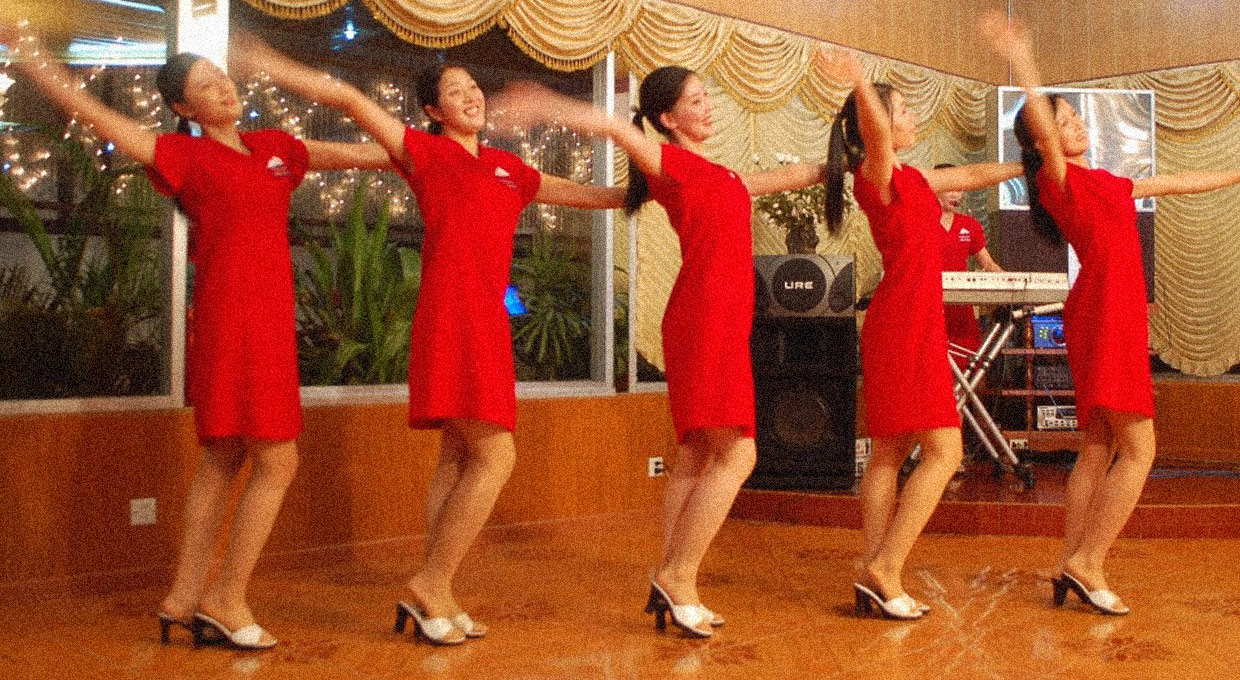How does eating North Korean food overseas compare with eating it in North Korea? I had been in the Cambodian capital of Phnom Penh some weeks before I heard of the Pyongyang Restaurant, a somewhat unobtrusive looking place, found after a sweaty search along the capital’s sweeping Monivong Boulevard.
The place was empty of patrons and rather to my disappointment, no karaoke machine filled the dining area with such rousing anthems as ‘Reunification Rainbow’ or ‘We Shall Hold Bayonets more Firmly.’ Other customers have been treated to dancers in chosŏn-ot singing Korean folk songs or playing traditional instruments. This, however, was a slow night.
The walls were wood panelled and adorned, not with the smiley bespectacled faces of the Great and Dear Leaders, but with paintings of a distinctly rustic nature. Seascapes erupted in sprays of froth. Mountains and fir trees were veiled in gossamer mists. A rose bud chandelier hung from the ceiling and the strip neons, reflected on the tiled floors and pastel surfaces, accentuated the cool effect.
The waitress, dressed in a kind of blue and red pinafore dress, could understand snatches of my English. But I did not get much out of her beyond that she was from Pyongyang. The hazards of waitressing the world over are manifold. There are obnoxious children to deal with, insanely fussy eaters who send everything back, lecherous males and miserly tips. The expatriate North Korean faces another hurdle: foreigners with the temerity to criticise the Juche system and the benevolent rule of the Kim dynasty.
With that in mind, it is believed that these waitresses must undergo a year of indoctrination prior to deporting for a foreign assignment. The skin of the young woman who guided me to one of the glass topped tables had an alabaster paleness. This seemed odd with all that stinging Cambodian sunshine around. Or perhaps not: the restaurant staff are provided for to the extent that they seldom leave the compounds, and are always with minders present.
If, as has been alleged, these restaurants contained concealed microphones or cameras, the unseen operative was in for a boring night.
Erring on the side of conservatism, I ordered myself a helping of Korea’s celebrated spiced cabbage. It has been noted that kimchi tends to become more tart and spicy the further south you travel on the Korean peninsula. Perhaps so, but my helping, coupled with the dehydrating effect of the Phnom Penh night, soon had me gasping for water. To my shame, given what was later related to me about starvation in the DPRK, noticeable portions languished on the plate when the waitress returned.
Recent accounts of visits to North Korean restaurants describe strict curfews against the taking of photographs. But the waitresses did not demur when I asked them to pose for pictures with me.
In North Korea itself, the experience of eating out proved to be rather different. In Pyongyang, there had been no long walks down boulevards, no rubbernecking street signs. That was fortunate for the streets were drifted in snow as our bus came to a halt near a hulking building with a multi-layered roof. A door opened into freezing darkness and flashlights threw great flapping shadows around the corridor. Woollen hats on our heads and scarves around our necks, we took care not to slip on the polished granite tiles underfoot.
A quite breathtakingly pretty waitress in a blue chosŏn-ot dress escorted us into a dark room with a partition behind which a candlelit table awaited us. While we worked away on our meals, the electricity returned for about an hour.
Sounds emanated from the other side of the partition: a flat screen television had flickered into temporary life, surreptitiously regarded by two of the waitresses. When I strained my head around to get a look, on the screen a middle-aged father with a very early Nineties shell suit seemed to be laying down the law to his teenage daughter…a DVD of some South Korean family drama? By the time we were full, we were once again being guided by torchlight along freezing corridors and out into the even more freezing city.
North Korean-run restaurant chains may be expanding across Asia, but so far, the one attempt to bring a taste of the Hermit Kingdom to Europe, has proven premature. The much vaunted ‘Pyongyang’ Restaurant in the suburbs of Amsterdam lasted just a few months this year until disputes between the Dutch and North Korean partners became insurmountable. But in London, at least, I was able to enjoy North Korean dishes, prepared and shared with North Koreans.
Sometime after my Phnom Penh and Pyongyang repasts, I met a few of London’s exiled North Korean community. The get together included my first guilt free helping of northern cuisine in the apartment of one member of the group. Guilt free, that is, until one of them, a former soldier from North Hamgyong province quite nonchalantly recalled regularly seeing dead bodies on the roadside in the mid 1990s. This was when North Korea was wracked by a famine that the regime has termed ‘The Arduous March.’ He also described a general reluctance on the part of people in his area to venture out after dark amid rumours of murder and cannibalism. An image, common to both restaurants, crept into my mind at that point: portions of uneaten food on my plate.
But that is not to belittle the gastronomic experience. Rather like North Korea itself, North Korean food is a world of its own.
